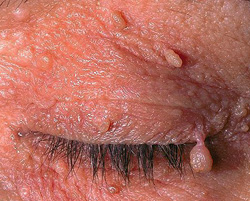If you’ve ever noticed a small, soft bump on your neck, underarm, or groin area, you’re not alone. These little growths—often called skin tags—are incredibly common. Medically, they’re known as acrochordons, fibroepithelial polyps, or papillomas, but don’t let those fancy names fool you. They’re harmless, skin-colored bits of tissue that can appear on anyone.
Skin tags tend to pop up in places where your skin rubs together or against clothing, like the underarms, neck, eyelids, chest, or groin. They usually start out small, about 1 to 3 millimeters in size, but some can grow larger over time. They’re soft to the touch, painless, and—thankfully—non-cancerous.

So, if they’re harmless, why do people want to know how to prevent skin tags? Because even though they don’t pose a medical risk, they can be irritating, get caught on jewelry or clothing, and for many people, they’re just not something they want on their skin. Let’s take a closer look at why they form, what causes them, and what you can do to prevent (and safely remove) them.
What Causes Skin Tags?
The exact cause of skin tags isn’t completely understood, but most dermatologists agree that friction plays a major role. Anywhere skin rubs against skin or fabric, small folds can form that encourage the development of a skin tag.
Common contributing factors include:
- Friction: Repeated rubbing in areas like the neck, underarms, or groin.
- Hormonal changes: Pregnancy and hormonal fluctuations can make skin tags more likely.
- Obesity or weight gain: More skin folds can mean more friction.
- Genetics: Some people are simply more prone to developing them.
- Insulin resistance or diabetes: Skin tags are seen more often in those with metabolic conditions.
- Age: They’re most common in adults over 40, though they can appear at any age.
In short, they happen because your skin reacts to constant friction or minor irritation by creating extra tissue. And while you can’t always control every factor (like genetics or hormones), there are definitely steps you can take to prevent skin tags from forming or returning.
How to Prevent Skin Tags
There’s no guaranteed way to stop skin tags from ever appearing, but you can reduce your risk with a few smart lifestyle and skincare habits.
1. Keep Friction to a Minimum
Since friction is one of the main triggers, try to minimize it wherever you can.
- Choose loose, breathable clothing, especially in hot, humid weather.
- Avoid tight straps, necklaces, or collars that constantly rub your skin.
- Use body powders or anti-chafing creams on high-friction areas like your underarms, thighs, or neck.
A small change in your wardrobe or skincare routine can make a noticeable difference over time.
2. Maintain a Healthy Weight
Being overweight can increase skin folds and friction—two of the biggest contributors to skin tags. Maintaining a healthy body weight helps reduce that. Regular exercise and balanced nutrition can help your skin (and body) stay healthy overall.
3. Manage Blood Sugar Levels
People with insulin resistance or diabetes are more likely to develop skin tags. If you fall into that category, managing your blood sugar levels with the help of your doctor or nutritionist may reduce your chances of getting new ones.
4. Take Care of Your Skin
Keeping your skin clean, dry, and irritation-free is an easy but often overlooked step in prevention. After sweating or exercising, make sure to gently wash and dry areas that tend to rub, like the groin, neck, and underarms. Use mild cleansers and avoid harsh soaps or perfumes that can irritate the skin.
5. Avoid Home Remedies That Irritate the Skin
You may find online advice recommending you tie off or freeze skin tags at home, but that’s never a good idea. Not only can it cause infection or scarring, but it can also irritate the surrounding skin and even encourage more tags to form later. Prevention is about keeping the skin calm, not stressed.
What If You Already Have Skin Tags?
Even if you follow every prevention tip perfectly, skin tags can still show up. The good news is that they’re almost always benign (non-cancerous) and easy to remove if they bother you.
At Celibre Medical, a laser dermatology facility, we use a wide range of advanced lasers to treat many skin conditions. But here’s an interesting fact—removing skin tags isn’t something we do with lasers. While lasers are great for many procedures, skin tags respond better to a different method.
The Best Way to Remove Skin Tags: Electrodessication
The most effective way to remove skin tags is with a hyfrecator, a medical device that uses electrodessication. This treatment involves heating the tag with a fine probe or needle until it dries out and detaches from the skin. It’s a quick, safe, and clean process that provides immediate results.
While it can cause slight discomfort, it’s over in seconds, and the treated area usually heals within a few days. Most people find it well worth it for the smooth, tag-free skin that follows.
Can Skin Tags Come Back After Removal?
Once a skin tag is removed, that specific one won’t come back. However, new ones can appear in other areas over time, especially if the same risk factors (like friction or insulin resistance) remain. That’s why prevention habits—like maintaining a healthy weight and minimizing skin friction—are key for the long term.
When to See a Dermatologist
Skin tags are almost always harmless, but if you notice a growth that changes color, shape, or size, it’s best to get it checked out by a professional. Not every skin bump is a tag, and it’s always better to rule out other conditions.
Take action
Skin tags are incredibly common, harmless little growths that almost everyone will deal with at some point. While there’s no way to completely stop them from forming, you can significantly reduce your risk by keeping your skin clean, dry, and friction-free, maintaining a healthy weight, and managing your blood sugar levels.
And if you already have a few, don’t worry—they can be safely and easily removed by a professional using electrodessication.
At the end of the day, knowing how to prevent skin tags is about understanding your skin, treating it gently, and taking small steps that help it stay healthy and comfortable.

